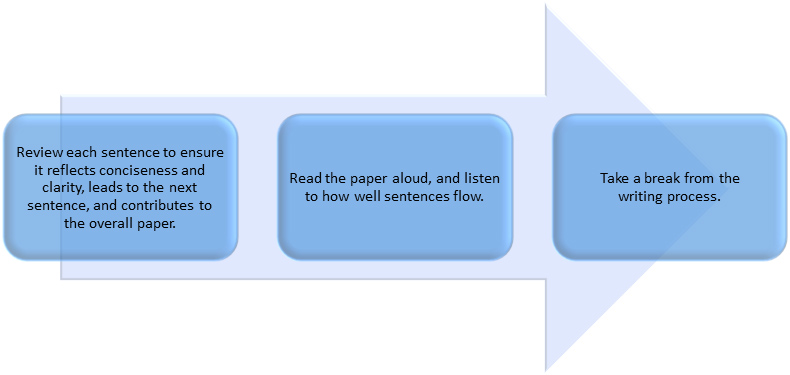- 1. Make a Commitment to Improving Your Writing Skills
According to Johnson and Rulo (2019), good writers remain essential for the future of the nursing profession. Learning to write well is a skill, and like any skill, it requires practice and commitment. This skill helps you to excel in your profession by promoting efficiency of information in collaborative care, developing business plans to sustain health-care efforts, and creating programs to address the health of populations. This commitment involves using critical thinking to learn the writing process, to master rules of grammar and writing mechanics, and to take the time to write.
- 2. Understand the Writing Process
The writing process includes pre-writing, drafting, and revision.
- A. Create an outline during the pre-writing process to map out content.
Visit How to write an outline for additional help. (https://www.grammarly.com/blog/how-to-write-outline)
- Organize articles, notes, and thoughts (provides frame or angle for paper).
- Write the objective or thesis statement at the top of the paper (everything you write should support this statement).
- Review documents, and write down the main ideas. Make sure what you use supports the statement at the top of the paper.
- Organize main ideas from the last step, and decide how to present them. Some examples include the following:
- Begin with the weakest point moving to the strongest.
- Compare and contrast.
- Give information chronologically, showing evolution.
- Show relationship or cause-effect, opposites, or consequence.
- Outline the process.
- Define issue and components.
- Give testimony of experts and show data.
- Keep presentation method consistent throughout the paper.
- B. Follow these steps and examples.
Use the following steps and examples to assist you in your writing.
1. Write cohesive paragraphs.
Review your outline and choose the ideas to cover in your content. Each idea should be the first sentence in the paragraph, and all the content should relate to the first sentence.
2. Maintain continuity and flow in your writing by connecting your thoughts.
Connect thoughts by using a word in the preceding sentence.
Correct: The program focuses on approaches that promote active living. Schools have adopted this program to encourage students to become physically active.
Incorrect: The program focuses on approaches that promote active living. Students are encouraged to become physically active.
Connect thoughts by using transitional words.
Correct: Particles inhaled through vaporized nicotine are linked to asthma, stroke, heart disease, and diabetes. In addition, nicotine is dissolved in solvents that is linked to carinogenic activity.
Incorrect: Particles inhaled through vaporized nicotine are linked to asthma, stroke, heart disease, and diabetes. Nicotine is dissolved in solvents that is linked to carinogenic activity.
Examples of Flow
Example of good flow
Workplace civility is tied to employee satisfaction. Work environments infused with positivity, teamwork, empowerment, and supportive leaders result in job satisfaction and positive consumer experiences. To promote teamwork and a positive practice work environment, all entities must be actively involved including support personnel, employees, team leaders, and management. Education of all those working in an organization is vital to understand and identify workplace incivility.
Example of poor flow
Conflict is inevitable in varying degree when two or more individuals work together. Incivility in the workplace can occur in a variety of ways and is often tolerated and too frequently goes unrecognized. Methods of communication are often affected by dissatisfaction within the workplace. Education and tolerance empower employees. Work environments infused with positivity, teamwork, empowerment, and supportive leaders result in job satisfaction and positive consumer experiences. To promote teamwork and a positive practice work environment all must be actively involved including support personnel, employees, team leaders, and management. Education of all those working in an organization is vital to understand and identify workplace incivility.
- C. Construct a draft of the outline using the Race Car Driver technique.
Speedily release your creative ideas by forgetting sentence structures and grammar using the Race Car Driver technique.

- D. Organize information using the Architect technique.
Design content by selecting and organizing chunks of information using the architect technique.

- E. Ensure continuity and flow using the Carpenter technique.
Nail the sentence structure to ensure continuity and flow using the carpenter technique.

- F. Fine-tune your content using the Judge technique.
Examine the details of your content using the judge technique.

- G. Student Paper Example
This is an example of a student’s paper showing the completed writing process, using the 3-prong approach, which includes the following:
- Tell your audience what you are going to tell them.
- Tell them.
- Then tell them what you told them.
Supervisory Support for Nurse Burnout
Introductory Paragraph
One in three nurses leaves the nursing profession within the first two years of practice (Blair, 2014). Short-staffed units, both inpatient and outpatient, experience decreased quality patient care, which results in substandard care. Standards for quality of care are at the forefront of research, and hospital organizations are not reimbursed for substandard care. To rectify the increasing number of nurses leaving facilities and the profession, hospital administrators need to focus their efforts on the retention of nurses, which increase staff satisfaction and maintain safer health-care environments (Lartey et al., 2014). Addressing nurse burnout and turnover involves examining the problem, recognizing benefits of the intended recipients, using interdisciplinary teamwork, and sharing ways to advance nursing practice through dissemination of project results.
Introduction: Tell your readers what you are going to tell them.
Show general background statement(s) that grab your readers' attention.
Narrow topic to the thesis statements.
State the intent of the paper, so your readers know what to expect.
 Write your introduction last to align it accurately with the content.
Write your introduction last to align it accurately with the content. Main Idea: Relate all content in the paragraph to the main idea.
Main Idea: Relate all content in the paragraph to the main idea.Body
Statement of Problem
Lack of transformational managerial support and nurse engagement increases nurse burnout and turnover. According to Bakker and Albrecht (2018), work engagement is often defined as a positive, fulfilling, work-related state of mind that is characterized by vigor, dedication, and absorption. When these characteristics are lacking, work engagement declines, resulting in turnover. This leads to decreased nursing staff on a unit, which affects health-care costs, job satisfaction, and quality patient care (Lartey et al., 2014). In addition, excessive nursing turnover yields a loss of experience, skill, and knowledge for units, and these strengths can take time to regain (Lartey et al., 2014). Employment and improvement of nurse engagement combats the increasing number of nurses leaving the profession. To increase nurse engagement, nursing managers need to embrace a transformational support system. This master’s project will work to identify and address nurse burnout by improving nurse engagement through nurse manager professional development and training.
Ways Project Contributes to Intended Recipients
This master’s project benefits managers, nurses, and health-care organizations in the outpatient setting. Managers will likely experience accomplishment in their careers as they learn to promote connections and motivation among and with their staff members, as they address burnout and turnover with their nurses. Health-care organizations will likely experience an increase in quality of care, decreasing patient care costs and monies spent on hiring and training replacement nurses.
Rationale for Importance of Project
Nurse burnout has been a topic of nursing research since the 1980s when Maslach and Jackson (1981) identified nurse burnout as a syndrome that consists of three components, including emotional exhaustion, depersonalization, and a low degree of personal accomplishment. A multitude of research studies and case analyses of nurse burnout have been performed and have identified possible interventions that may combat nurse burnout and turnover. Included in these findings were increased supervisory support and engagement. However, a gap in knowledge remains on how to increase nurse retention (Garcia-Sierra et al., 2016; Gonzales, 2018; Khamisa et al., 2015; Minmin, 2015). This master’s project will fill in that gap by identifying how nurse manager education and training can improve nurse satisfaction and decrease nurse turnover.
Interdisciplinary teamwork
In the past decade, health care has experienced significant changes and has undergone a surfeit of transformations turning health-care organizations into more interdisciplinary collaborations (Bogaert et al., 2018). Such changes have led to complex processes between multiple disciplines and increases the number of stakeholders when patient care is affected (Bogaert et al., 2018). This master’s project will include nursing, medicine, health-care administration, staff education department, and human resources.
Significance to advance nursing practice
The significance of this project is to discover evidence-based practices that reduce nurse burnout and to put them into practice. The aim of this project involves implementing interventions identified throughout recent research and trial it. Increasing nurse engagement and transformational supervisory support will potentially decrease nurse burnout and increase nurse retention.
Conclusion
Summary
Nurses are leaving the nursing profession within the first few years of training completion and furthering the short-staffing present in outpatient departments throughout the United States. Lack of nurses leads to poor quality of care for patients and further increases health-care costs and nurse burnout. By initiating a nurse manager professional training program, nurse managers will be capable of providing transformational support to their nursing staff. With this support, nurses will potentially have fewer burnout symptoms and higher engagement, increasing nurse retention in outpatient hospital organizations.
Concluding Paragraph
Then tell them what you told them.
- A. Create an outline during the pre-writing process to map out content.
- 3. Analyze Your Rhetorical Situation
Identifying your rhetorical situation strengthens your message and helps to organize your writing.
- Purpose:
- Writer:
- Audience:
- Message:
- Context:
- Reduce the number of nurses leaving the profession.
- Nurse
- Health-care management
- Hospital administrators need to focus their efforts on the retention of nurses, which increase staff satisfaction and maintain safer health-care environments.
- Nurses experiencing burnout in the outpatient setting of health care.
- 4. Know the “Tools and Rules” of Writing
- A. Active versus passive voice
For clear and concise writing, use the active voice as much as possible. Active or passive voice depends on the verb, subject, and object relationship.
The format of the active voice includes the following order: subject, verb, and object.
The format of the passive voice includes the following order: object, verb, and subject.Example of Active Voice: Several factors link cancer and obesity. (subject, verb, and object)
Example of Passive Voice: Cancer and obesity are linked to several factors. (object, verb, subject)
Avoid beginning sentences with “there” or “it,” which helps promote the active voice. Avoid using “be” words whenever possible to promote the active voice, such as is, am, are, was, were, be, being, been, has, have, had, do, does, did, shall, should, will, would, may, might, must, can, could.
- B. Parallel construction means using the same structures.
These structures include nouns with nouns, verbs with verbs, adjectives with adjectives, prepositional phrases with prepositional phrases, and so on.
1. Example: Items in a series
Correct: Huddles on the unit improve communication, increase productivity, and promote nurse satisfaction. (Verb required for parallel construction.)
Correct: Single-checking promotes accountability, adherence to medication administration procedures, and appraisal of one’s knowledge of drugs. (Noun required for parallel construction.)
Incorrect: Huddles on the unit improve communication, increase productivity, and nurse satisfaction.
Incorrect: Single-checking promotes accountability, adherence to medication administration procedures, and updating one’s knowledge of drugs.
2. Example: Vertical list
Boxes outline vertical lists
Correct: Post-Assessment Education
- Performed by the discharge nurse
- Used to assess education given throughout stay
- Completed to customize discharge education for patients
Incorrect: Post-Assessment Education
- Performed by the discharge nurse
- Used to assess education given throughout stay
- Help in customizing discharge education for patients
3. Example: Coordinate Ideas
Coordinate ideas when using conjunctions (such as for, and, nor, but, or, yet) by ensuring they are paired in similar grammatical form. Use the same format for comparisons created by than or as.
Correct: Administrators benefit from this educational process by ensuring quality care and by decreasing readmissions.
Incorrect: Administrators benefit from this educational process by ensuring quality care and decreasing readmissions.
4. Example: Two-part connectives
Two-part connectives include either/or, neither/nor, not only/but also, both/and. After the first word, make sure to insert the second word.
Example: The palliative care team can treat the symptoms that result not only from the disease but also from treatment for the disease.
- C. Restrictive (essential) versus non-restrictive (nonessential) clauses.
Learn when to use “that” or “which.” Use “that” for essential information to understand the main idea. Use “which” for nonessential information, meaning the information is not required to understand the main idea. A guideline to remember includes the following: “that defines, which describes.”
Example: Palliative care medicine is a subspecialty of medicine that focuses on managing symptoms of chronic and terminal illnesses.
Example: Approach of palliative care remains centered on both the patient and family, which improves quality of life for all involved.
- D. Subject-verb agreement
Example
Correct: The data estimate the prevalence of metabolic syndrome in this population. (Data is plural, so the verb needs to agree–estimate.)
Correct: Patient and family benefit from hospice care. (Subject is plural (patient and family), so verb needs to agree–benefit.)
Incorrect: The data estimates the prevalence of metabolic syndrome in this population.
Incorrect: Patient and family benefits from hospice care.
- A. Active versus passive voice
- 5. Create the Frame for Your Assignment, Project, or Research Study
Framing is also described as “finding an angle for a story” and involves ways information is organized, simplified, interpreted, and perceived. The term angle was introduced in the pre-writing process of creating an outline. The frame for your content reflects the “big picture.” How you frame your content can influence your readers’ perceptions, help them to connect with new information by what they already know, elicit questions about complex issues, and provide different types of perspectives. Some ideas for framing your writing include the following:
- Begin with the weakest point moving to strongest.
- Compare and contrast.
- Give information chronologically, showing evolution.
- Show relationship or cause-effect, opposites, or consequence.
- Outline the process.
- Define the issue and components.
- Give testimony of experts and show data.
- 6. Consider the Beginning and Ending of your Assignment or Chapter
Write an effective introduction by grabbing the reader’s attention, stating your thesis statement, and telling your readers what to expect. (Tip: Write your beginning at the end.)
The introduction is the first paragraph of your paper (or presentation to your staff). This paragraph should get the readers' attention and convey what to expect in the remainder of the paper. The structure of the introduction reflects a funnel-shaped format: (a) show general background statement, (b) narrow the topic to the thesis statement, and (c) state the purpose/intent of the paper.
Example of an introductory paragraph: According to the Centers for Disease Control and Prevention (CDC, 2017a), chlamydia is the most frequently reported communicable disease. Incidence rates of chlamydia have been increasing in recent years, raising concerns with community health nurses. These rates are examined by reviewing the most recent local and national chlamydia statistics, potential barriers to accurate reporting, and health disparities related to the disease.
Creating the conclusion reflects the last statement in the 3-prong approach of “then tell them what you told them.” In the conclusion, you synthesize the thesis statement with the main ideas. Think of the conclusion as the last words to your readers. What do you want them to remember? Avoid introducing new information in the conclusion.
- 7. Choose Your Words Carefully
- A. Use bias-free language
Use bias-free language by avoiding “demeaning attitudes” in your writing related to “age, disability, gender, participation in research, racial or ethnic identity, sexual orientation, socioeconomic status, . . . other personal factors” (APA, 2020, p. 131).
(https://apastyle.apa.org/style-grammar-guidelines/bias-free-language/#:~:text=The%20American%20Psychological%20Association%20emphasizes,demeaning%20attitudes%20in%20their%20writing.)
Correct: Patients receiving chemotherapy experience side effects.
Incorrect: Chemotherapy patients experience side effects.
- B. Promote conciseness and clarity by avoiding wordiness and redundancy
Correct: The nurses will participate in these exercises for six weeks to expose each nurse to multiple exercises. (Deleted “in an effort.”)
Correct: The results will be compared to decide on the effectiveness of the exercises. (Deleted “to make a determination.”)
Incorrect: The nurses will participate in these exercises for six weeks in an effort to expose each nurse to multiple exercises.
Incorrect: The results will be compared to make a determination to decide on the effectiveness of the exercises.
Avoid using extra words in your writing, such as in light of, in order, in fact, very.
- C. Avoid slang, colloquialisms, and contractions
Slang or jargon includes terminology used by a specific group.
Correct: The nurse checked the results of the complete blood count (CBC).
Incorrect: The nurse checked the results of the CBC.
Colloquialisms include informal expressions.
Correct: Smith and Jones (2020) indicate the rise of obesity in children remains a problem.
Incorrect: Everyone knows that obesity is a problem in children.
Avoid contractions.
Correct: The current average length of stay does not allow for the full benefits of hospice services.
Incorrect: The current average length of stay doesn’t allow for the full benefits of hospice services.
- D. Avoid anthropomorphism
Avoid attributing human actions to nonhuman sources.
Correct: The nurses on the unit plan to educate the patients about the treatment plan.
Incorrect: The unit plans to educate the patients about the treatment plan. (The unit is not human.)
Correct: This assessment shows the questions.
Incorrect: This assessment asks the questions. (The assessment is not human.)
- E. Avoid using a pronoun when readers cannot tell whom/what it refers to.
Correct: The improper association of palliative care with strictly end-of-life care is a barrier to referral. This barrier highlights the need for education directed at overcoming that stigma and expanding the meaning of palliative care.
Incorrect: The improper association of palliative care with strictly end-of-life care is a barrier to referral. This highlights the need for education directed at overcoming that stigma and expanding the meaning of palliative care.
Eliminate ambiguity by telling the reader what the pronoun refers to, such as that report, these symptoms, and those patients.
- F. Use commas correctly to help your audience read your words with ease.
1. Insert a comma between two complete sentences with a conjunction (and).
Correct: JUULs are e-cigarettes that look like USB ports, and they have a high level of nicotine.
Incorrect: JUULs are e-cigarettes that look like USB ports and they have a high level of nicotine.
2. Insert commas between elements.
Correct: Typical conditions include gastroesophageal reflux disease, gallstones, ulcerative colitis, and hepatitis.
Incorrect: Typical conditions include gastroesophageal reflux disease, gallstones, ulcerative colitis and hepatitis.
3. Insert a comma after an introductory phrase.
Correct: At each grade level, teachers plan to implement the new program.
Incorrect: At each grade level teachers plan to implement the new program.
4. Insert commas to set off nonessential clauses.
Nonessential clauses: The clause adds further information, but when the clause is removed, the meaning and structure of the sentence remain intact.
Correct: Behavior interventions, such as teaching new coping skills, were also helpful in reducing the caregiver’s level of stress.
Correct: National obesity rates for adolescents are considerably higher than Utah’s rates, which is attributed to several factors.
Correct: Specific health districts have higher rates of children with obesity, including Tooele, Weber-Morgan, Salt Lake Central, and Bear River.
Incorrect: Behavior interventions such as teaching new coping skills were also helpful in reducing the caregiver’s level of stress.
Incorrect: National obesity rates for adolescents are considerably higher than Utah’s rates which is attributed to several factors.
Incorrect: Specific health districts have higher rates of children with obesity including Tooele, Weber-Morgan, Salt Lake Central, and Bear River.
- A. Use bias-free language
- 8. Write, write, and write again—using your own words.
As you progress in writing, you move through different stages from roughly sketching out your ideas to ultimately attending to the final details. These stages or techniques, race car driver, architect, carpenter, and judge, support you in the writing process. Notice each technique concludes with “take a break,” and you decide on the length of the break. However, after creating your draft (race car driver technique), one suggestion is taking a break from the writing process for a day. This action allows you to see your content with a new perspective. If you feel stuck with your writing, then write the easy sections first. Remember learning to write well is a skill, and like any skill, it requires practice and commitment. This skill will help you excel in your professional career.
When you write, use your own words.
Familiarize yourself with the WSU Annie Taylor Dee SON plagiarism policy below. In addition, make sure you understand what constitutes plagiarism. See activity below.
Plagiarism
- The WSU Annie Taylor Dee SON has a no-tolerance plagiarism policy. All student work is expected to be referenced correctly.
- When using the WSU SON internet-based plagiarism tool, a students’ paper resulting in 21% or greater amount of plagiarism will result in one of the following two actions:
- Based on course/assignment details, the student may take the opportunity to read the plagiarism report and rewrite the assignment in order to lower the plagiarism percentage; or
- Based on results of the internet-based plagiarism tool, faculty or instructor may proceed with the Academic Integrity Policy on violations and sanctions.
Paraphrasing
Professional writers need to know how to paraphrase effectively. See the quoted sentence: “Chickenpox is a highly contagious viral infection in which a person develops extremely itchy blisters all over the body” (Kaneshiro, 2013, para. 1).
When paraphrasing, notice how the sentence and word structures change: Varicella remains an infectious viral illness with a blister-like rash on the body, causing severe itching (Kaneshiro, 2013).
Activity: Evaluate each sentence for plagiarism.
- Chickenpox is a highly contagious viral infection in which a person develops extremely itchy blisters all over the body (Kaneshiro, 2013, para. 1).
No quotation marks
- Chickenpox is a contagious viral infection with extremely itchy blisters all over the body (Kaneshiro, 2013, para. 1).
Too many words from the original sentence
- “Chickenpox is a highly contagious viral infection in which a person develops extremely itchy blisters all over the body.”
No reference
- Chickenpox is a highly contagious viral infection in which a person develops extremely itchy blisters all over the body.
No quotation marks and no reference
- “Chickenpox is a highly contagious viral infection in which a person develops extremely itchy blisters all over the body” (Kaneshiro, 2013, para. 1).
Correct Example
Kaneshiro, N. K. (2013). Chickenpox. Medline plus medical encyclopedia. Retrieved from http://www.nlm.nih.gov/medlineplus/ency/article/001592.htm
- 9. Create an Action Plan
Writing Process
As you progress in writing, you move through different stages from roughly sketching out your ideas to ultimately attending to the final details.

Racecar Driver Technique
Speedily release your creative ideas by forgetting sentence structures and grammar using the racecar driver technique.
- Insert the main points from your outline on your paper with spaces in between. (Tip: Ensure main points reflect assignment directions and rubric.)
- Give yourself a time limit for writing your draft. Get ready and go!
- Go for quantity!
- Don't stop to design, build, or judge your content
- Write quickly!
- Start on any main point.
- Keep going!
- Take a break from the writing process.

Architect Technique
Design content by selecting and organizing chunks of information using the architect technique.
- Delete irrelevant information
- Arrange information in cohesive paragraphs:
- Insert the main idea in the first sentence of the paragraph.
- Relate all content in the paragraph to the main idea.
- Design the introduction to reflect a funnel-shaped format:
- Show general background statement(s).
- Narrow the topic to the thesis statement.
- State the purpose/intent of the paper.
- Include a summary of the main points and thesis statement in the concluding paragraph.
- Take a break from the writing process.

Carpenter Technique
Nail the sentence structure to ensure continuity and flow using the carpenter technique.
- Review each sentence to ensure it reflects conciseness and clarity, leads to the next sentence, and contributes to the overall paper.
- Read the paper aloud, and listen to how well the sentences flow.
- Take a break from the writing process.

Judge Technique
Examine the details of your content using the judge technique.
- Inspect spelling. Spelling should conform to the Merriam-Webster.com Dictionary per APA guidelines.
- Read aloud and listen to the grammar and tone of your paper.
- Check punctuation using the APA Manual, 7th edition.
- Check the APA format using the 7th edition.
- Ask yourself—if the audience is unfamiliar with the topic, have I demonstrated clarity and depth so that the audience will easily understand the content?
Flowers, B. S. (2014). Madman, architect, carpenter, judge: Roles and the writing process. Intellectual Entrepreneurship. Retrieved from http://www.ut-ie.com/b/b_flowers.html
See also: The Stages and Techniques of the Writing Process (https://www.weber.edu/wsuimages/ProfessionalWritingForNurses/Stages-and-Techniques-of-the-Writing-Process.pdf)
- 10. Collaborate
Good writing requires revisions, which includes soliciting feedback from faculty, peers, and content experts. Learning to feel comfortable with receiving and giving feedback remains essential for improving your writing. Another means of soliciting feedback is through the Writing Center at Weber State University, which provides online tutoring.

Professional Writing for Nurses
Nurses working in the complex health-care system require clear, concise, and accurate writing. Good writing supports strong verbal skills, promoting effective communication among health-care teams. The content below shows ways to develop good writing not only in school but also in your professional career.
Writing Topics
- 1. Make a Commitment to Improving Your Writing Skills
- 2. Understand the Writing Process
- 3. Analyze Your Rhetorical Situation
- 4. Know the “Tools and Rules” of Writing
- 5. Create the Frame for Your Assignment, Project, or Research Study
- 6. Consider the Beginning and Ending of your Assignment or Chapter
- 7. Choose Your Words Carefully
- 8. Write, write, and write again—using your own words.
- 9. Create an Action Plan
- 10. Collaborate
